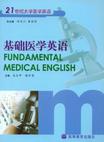基础医学英语
出版时间:2002-10-01 出版社:高等教育出版社 作者:高宝坤 页数:398
Tag标签:无
前言
改革开放以来,随着我国对外交往和学术交流的不断深入,社会对专业技术人员的外语水平要求也越来越高。在这种形势下,我国对大学英语教学进行了一系列改革和创新,取得了很大成绩。但是应用提高阶段的专业英语尤其是医学专业英语的教学还很薄弱,其中一个重要原因是医学专业英语教材的改革和创新与时代的发展和需要极不适应。为了深化医学英语教学改革,使广大医学院校的本科生、研究生尽快掌握21世纪迫切需要的、在一定专业领域内以英语为工具进行信息交流的能力,根据教育部《大学英语教学大纲[修订本]》的要求,我们组织国内部分医学院校具有丰富教学经验的教授、专家编写了《21世纪大学医学英语》系列教材。 本系列教材在编写过程中注意突出时代性和实用性。选材充分注意到了反映最新的医学科技发展状况,体现现代医学理念,改变专业英语即是专业阅读这种单一的教学模式,兼顾了听、说、写、译诸方面的能力培养,安排了一系列适合语言运用能力提高的练习。本系列教材还特别注意了与大学英语四、六级教学要求的衔接,以利学生从大学英语基础阶段到应用提高阶段的专业英语的平稳过渡和提高。 本系列教材由《基础医学英语》、《临床医学英语》、《医学英语听与说》、《医学英语写作与翻译》四册组成。 本书为《基础医学英语》,共18课。每课由两部分组成:Section A为术语,Section B为两篇文章。书后附有练习答案,Passage A的译文和词汇表。
内容概要
本系列教材由《基础医学英语》、《临床医学英语》、《医学英语听与说》、《医学英语写作与翻译》四册组成。 《基础医学英语》共18课。每课由两部分组成:Section A为术语,Section B为两篇文章。书后附有练习答案,Passage A的译文和词汇表。
书籍目录
Unit 1 Section A TerminologySection B PassagesPassage A The Skeletal SystemPassage B Amplication of DNA by the Polymerase Chain ReactionUnit 2 Section A TerminologySection B PassagesPassage A The Brain and Its FunctionsPassage B Other Parts of the Nervous SystemUnit 3 Section A TerminologySection B PassagesPassage A BloodPassage B General Princi ple of PhysicaI ExaminationUnit 4 Section A TerminologySection B PassagesPassage A The Endocrine SystemPassage B Action and Secretion of HormonesUnit 5 Section A TerminologySection B PassagesPassage A The Digestive SystemPassage B Cl inical and Pathological Conditions of the Digestive SystemUnit 6 Section A TerminologySection B PassagesPassage A Urine FormationPassage B PathophysioIogy of the KidneysUnit 7 Section A TerminologySection B PassagesPassage A Uterus and Menstrual CyclePassage B Fertilization,Implantation and Early DevelopmentUnit 8 Section A TerminologySection B PassagesPassage A The Cardiovascular SystemPassage B Factors Determining Arterial Pressure and HypertensionUnit 9 Section A TerminologySection B PassagesPassage A Respiratory System(I)Passage B Respirator~y System(Ⅱ)Unit 10 Section A TerminologySection B PassagesPassage A TumorPassage B CancerUnit 11 Section A TerminologySection B PassagesPassage A Cell DeathPassage B Clones:Will There Be"Carbon Copy"People?Unit 12 Section A TerminologySection B PassagesPassage A The Relationshi ps Between Epstein-Barr Virus,Malignancy,and ImmunodeficiencyPassage B HIV in Older AdultsUnit 13 Section A TerminologySection B PassagesPassage A Genetic Transfer Mechanisms and the Transmission of Drug Resistance in BacteriaPassage B Genetic CounselingUnit 14 Section A TerminologySection B PassagesPassage A Definition and Nature of InflammationPassage B The Control of Microorganisms by Chemical AgentsUnit 15 Section A TerminologySection B PassagesPassage A PathologyPassage B Classification of DiseaseUnit 1 6 Section A TerminologySection B PassagesPassage A Pharmacodynamics and PharmacokineticsPassage B Tumor PathologyUnit 17 Section A TerminologySection B PassagesPassage A Animal ExperimentPassage B NursingUnit 18 Section A TerminologySection B PassagesPassage A Psychology:the Search for UnderstandingPassage B Health Care SystemKey to Exercises参考译文Glossary
章节摘录
The Airways and BIood Vessels para 1 During inspiration air passes through either the nose(the most com- mon site)or mouth into the pharynx(throat),a passage common to both air and food.The pharynx branches into two tubes,the esopha- gus through which food passes to the stomach,and the larynx, which is part of the airways.The larynx houses the vocal cords, two folds of elastic tissue stretched horizontally across its lumen. The flow of ai r past the vocaI cords causes them to vibrate,produ. cing sounds.The nose,mouth,pharynx and larynx are termed the upper airways. para 2 The larynx opens into a long tube,the trachea,which in turn bran- ches into two bronchi,one of which enters each lung。Within the lungs,there are more than 20 generations of branchings,each resul- ting in narrower,shorter,and more numerous tubes.The walls of the trachea and bronchi contain cartilage.which gives them thei r cy- lindrical shape and supports them.The first ai rway branches that no longer contain cartilage are termed bronchioles.Alveoli first begin to appear,attached to the walls of respiratory bronchioles。The number of alveoli increases in the alveolar ducts,and the airways then end in grapelike clusters consisting entirely of alveoli.The air- ways,Iike blood vessels,are surrounded by smooth muscle,the contraction or relaxation of which can alter airway radius. para 3 The airways beyond the larynx can be divided into two zones:(1) The conducting zone extends from the top of the trachea to the be- ginning of the respiratory bronchioles;it contains no alveoli and there is no gas exchange with the blood.(2)The respiratory zone, which extends from the respiratory bronchioles on down,contains alveoli and there is an exchange of gases with the blood.
图书封面
图书标签Tags
无
评论、评分、阅读与下载
